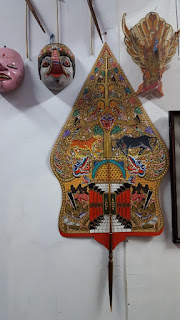The golek are most often made of lami wood. It is a medium weight wood.
The Wayang golek are three dimensional figures. These figures are not backlit during plays.
The Bima character represents strength. Notice the snake. Story goes that Bima was going to kill the snake but the snake asked to not be killed and promised in exchange he would help protect him. Bima and the snake became friends.
Side Note: At one time, puppet faces resembled human faces to a great extent. Once Islam arrived, Javan puppet faces could no longer resemble human faces. Bali puppet faces still resemble a human face we were told. For me none of these puppets has what I'd call a human face.
The museum has puppets from many parts of the world. Often, a puppeteer was given a local puppet following a performance of the Wayang Kulit. Those gifted puppets made their way into the museum. Puppets have also been gifted directly to the museum by foreign dignitaries.This first puppet is from Bangkok. I don't remember where the other three are from.
The Wayang kulit are 2 dimensional figures and are backlit during performances. Both types of Wayang require a dalang (sometimes spelled differently), or puppeteer, to perform the play. Yes, just one puppeteer. For a full scale production he may have a helper or two. There is a post from May 2015 if you care to read more about it.
Our guide showed us the highlights of the museum then in his nearby studio walked us through the production of each Wayang kulit and then performed a 15 mini play for us.
Note: How do you tell a male Wayang kulit character from a femaleW ayang kulit character? The female characters are smaller and have flatter heads.
These puppets have so many individual parts. This is a labeled part chart.
The most interesting step in the Wayang kulit production is that the water buffalo hide is hand sanded from pretty thick and opaque to thin and semi-transparent. This is very labor intensive. It can take weeks or months to create one puppet. Water buffalo is chosen because it is the only material that stands the test of time. Puppets can be hundreds of years old and even the colors applied are still bright. We also learned that you can't make any mistakes in cutting the pattern in the buffalo hide. It can't be repaired. You must start over. Why color it at all if the shadow is the "cast member"? Colors help the dalang identify the various characters. The casts of these plays is enormous.
This is a"life" puppet.
It's used to represent life, the natural world and more. Pak Aldy shines a flashlight onto the puppet and it casts a shadow on the ceiling.
The mini play was the story of Rama and Sita(or Sinta). Traditionally these plays lasted 9 hours. Ours was a brief summary in only 15 minutes. A romantic tale: boy has girl, boy loses girl, boy gets girl back with the help of a devoted friend. It was described to us as sort of a Romeo and Juliet but with a happy ending. Our play had only a few characters instead of the many in traditional plays. Pak Aldy says he has mastered 22 voices but some dalang can do 100 voices. The play was done in English and Pak Aldy threw in a lot of European and American references relevant to at least part of my group.
I also shot a very brief snippet of video during the play. At this point, Rama has proposed that he and Sinta marry. Rama says, "According to fortune teller, after I marry with you, my face will change. I become handsome guy like Tom Cruise."
Additional fun fact: Whole nutmeg is often used as an insect repellent in a container of sugar.













No comments:
Post a Comment
Feel free to comment or ask questions...